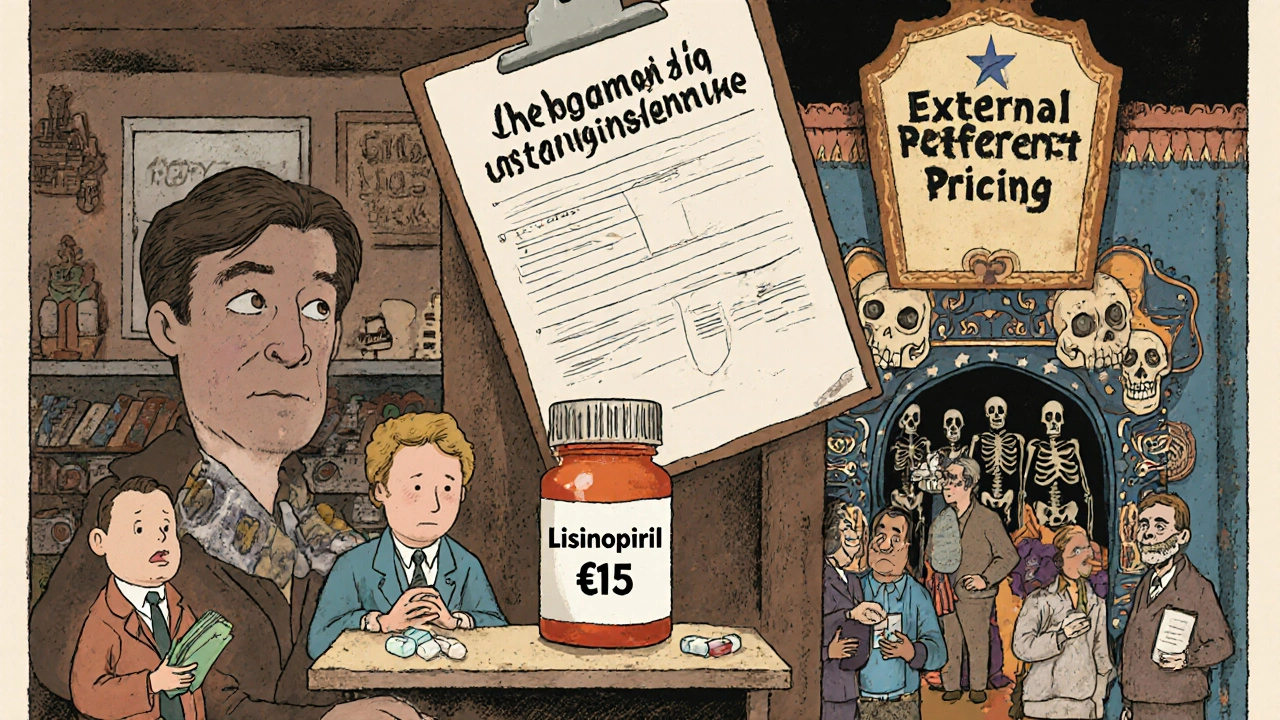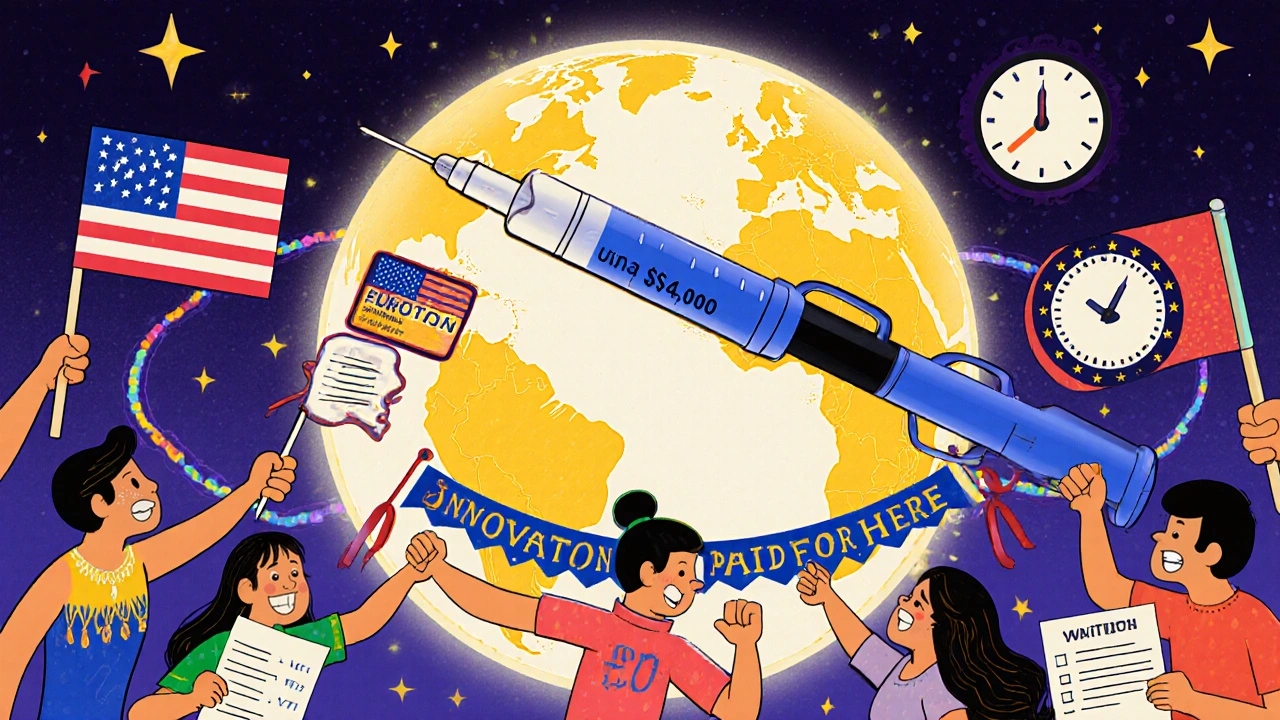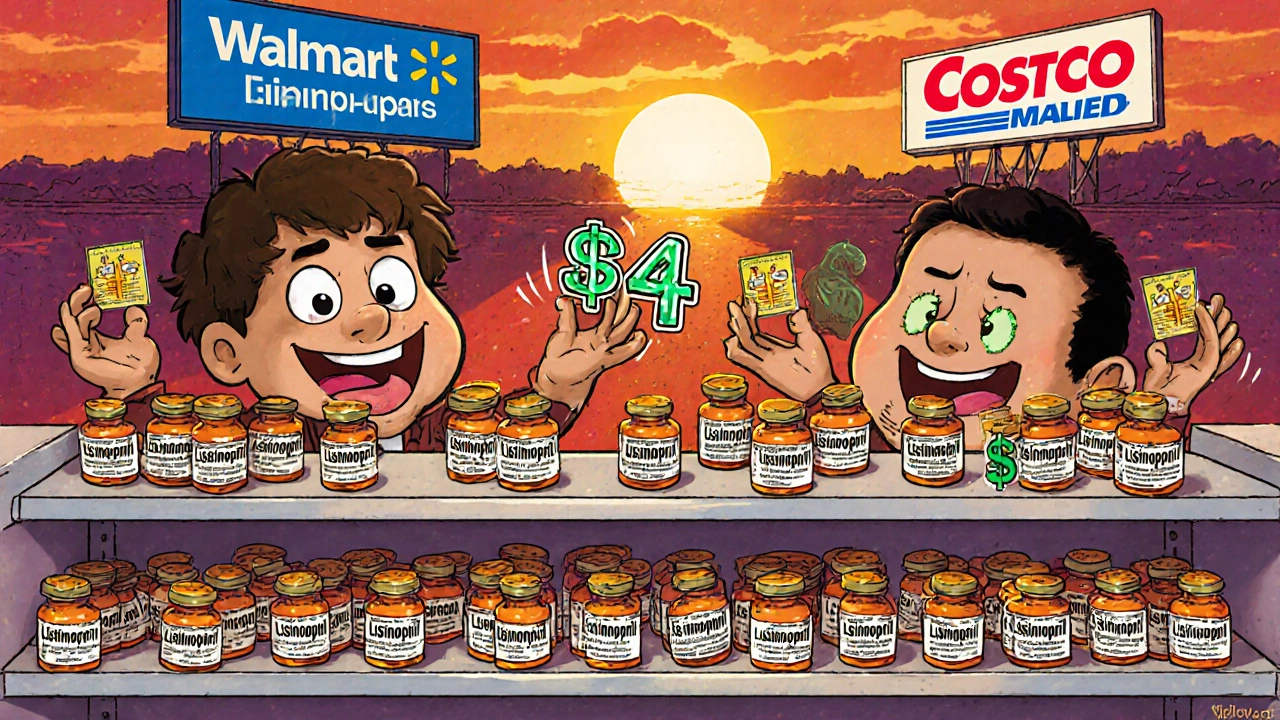It’s a strange truth: if you walk into a pharmacy in the US and ask for a generic version of high-blood-pressure medicine like lisinopril, you might pay $4. In Germany, the same pill could cost you €15-nearly four times as much. Meanwhile, if you need a brand-name drug like Jardiance or Stelara, you’ll pay far more in the US than almost anywhere else in Europe. This isn’t a mistake. It’s the result of two completely different systems, each working exactly as designed-but in opposite directions.
How the US Keeps Generic Drug Prices Low
The US doesn’t negotiate drug prices the way European countries do. Instead, it lets competition do the work. When a brand-name drug loses its patent, dozens of generic manufacturers rush in. Companies like Teva, Mylan, and Sandoz fight for market share by slashing prices. Some generics are sold below manufacturing cost just to get shelf space. That’s not sustainable long-term, but it works for now.
Pharmacy Benefit Managers (PBMs) play a big role. These middlemen negotiate rebates with drugmakers on behalf of insurers and Medicare. For brand-name drugs, they often get 35-40% off the list price. But for generics? There’s no rebate system. Instead, PBMs push pharmacies to stock the cheapest version available. Walmart, CVS, and Costco compete to offer $4 or even $0 co-pays on common generics. That’s why millions of Americans pay less than $10 a month for their generic meds.
And it’s not just big chains. The system is built for volume. The US fills over 90% of its prescriptions with generics. That kind of demand pulls prices down. In Europe, only about 41% of prescriptions are for generics. Less competition means less pressure to cut prices.
Why European Generic Drugs Cost More
European countries don’t rely on market competition to set prices. They use centralized systems. In Germany, France, and the UK, government agencies decide what a drug should cost-based on what other countries pay, how effective it is, and whether the health system can afford it.
Take France. They use a system called external reference pricing. If a generic drug costs €10 in Italy and €12 in Spain, France will set its price at or below €10. That keeps prices low-but only if other countries are already low. If no one else is selling it cheaply, France won’t budge. That’s why some generics stay expensive: no one’s pushing the price down.
Also, European pharmacies can’t always substitute a generic for a brand-name drug without a doctor’s OK. In France, pharmacists need permission to switch. In Germany, they can swap, but many patients still ask for the brand. That reduces pressure on manufacturers to lower prices.
And there’s less consolidation. Europe has hundreds of small generic makers. The US has a handful of giants. Big players can buy up competitors, control supply chains, and drive down costs through scale. Europe’s fragmented market can’t match that.

The Brand-Name Paradox: Who Pays More?
Here’s where things flip. For brand-name drugs, the US is the most expensive country in the world. A 2023 report from the U.S. Department of Health and Human Services found Americans pay 4.2 times more for brand-name drugs than people in other OECD countries. Even after accounting for hidden rebates, the gap stays huge.
Why? Because the US system doesn’t cap prices. Drugmakers set their own list prices, and insurers pay most of it. Patients pay co-pays, but the real cost is buried in premiums and taxes. In Europe, governments step in. The UK’s NICE evaluates whether a drug is worth the price based on health benefits. If it’s not, the drug doesn’t get covered. Germany negotiates directly with companies. The result? Lower list prices.
But here’s the catch: the US pays more because it funds global innovation. About two-thirds of all new drug research is paid for by American consumers and insurers. The IQVIA Institute says the US market grew 11.4% in 2024, mostly because of new, high-value drugs. European markets grew slower-not because people are healthier, but because they won’t pay for expensive new treatments.
That’s why experts like Dana Goldman from USC say Europe is “free-riding.” They get the benefits of innovation without paying the upfront cost. The US bears the risk. When a drug fails in trials, American companies absorb the loss. When it succeeds, they recoup it through high prices here.
What’s Changing? Medicare Negotiation and Global Pressure
The Inflation Reduction Act changed the game. For the first time, Medicare can negotiate prices for 10 high-cost brand-name drugs. In 2024, Medicare paid $204 for Jardiance. In other countries, the average price was $52. That’s still 3.9 times higher-but it’s down from the list price of over $1,000.
That’s just the start. By 2027, Medicare will be negotiating up to 60 drugs. That could cut US brand-name prices by 25-30%. But here’s the ripple effect: if the US pays less, drugmakers will need to make up the difference. Some experts warn they’ll raise prices in Europe and Canada to keep profits steady.
That’s why Alexander Natz of EUCOPE warned in late 2025 that “most favored nation” pricing-where the US matches the lowest global price-could slash US profits by $100 billion a year. That’s not a threat to the US. It’s a threat to global innovation. If drugmakers can’t make money in the US, they’ll cut R&D budgets everywhere.

What This Means for Patients
For Americans on Medicare or with good insurance, generics are cheap. Real cheap. You can get 30 days of metformin for $0. Generic lisinopril? $4. Atorvastatin? $5. It’s one of the few places in the world where that’s true.
But if you’re uninsured or underinsured, brand-name drugs are a disaster. A single month of Ozempic can cost $1,000. That’s why some Americans fly to Canada or Mexico for meds. Others skip doses. The system works for generics, but it’s brutal for new treatments.
In Europe, the opposite is true. Generic prices are higher, but brand-name drugs are often free or low-cost for patients. You don’t pay $1,000 for Ozempic-you pay €5 or nothing at all. But if you need a new drug that hasn’t been approved yet? You wait. And wait. And wait.
One Reddit user from Ohio wrote in January 2025: “I paid €15 for generic lisinopril in Berlin. Back home, my copay is $4. I thought I was being ripped off in the US. Turns out, I was getting a deal.”
Another from London said: “I saw a friend’s pharmacy bill from the US. $4,000 for one insulin pen. I cried. We pay €20 here. We don’t get the latest drugs fast, but we don’t go broke either.”
Will This Last?
The US generic market is under strain. When prices drop too low, manufacturers quit. We’ve seen shortages of antibiotics, thyroid meds, and even epinephrine because no one could profit from making them. Then one company buys up the rest and raises prices. That’s what happened with doxycycline and digoxin.
Europe’s system is stable but slow. New drugs take years to get approved. Patients wait. Innovation slows. The European Medicines Agency admitted in 2025 that their pricing rules may need updating to avoid losing access to breakthrough treatments.
Right now, the US wins on generics. Europe wins on brand-name access. But the balance is shifting. Medicare negotiation is starting to chip away at the US price premium. If it succeeds, drugmakers will have to raise prices elsewhere. If it fails, Americans will keep paying more for new drugs-and still get cheap generics.
There’s no perfect system. The US has efficiency but inequality. Europe has fairness but delays. And the world? It’s still relying on American spending to fund the next big drug. Whether that can last is the real question.


Comments (11)
Gina Banh
Let’s be real-Americans get ripped off on brand names, but we’re getting stolen blind on generics. $4 for lisinopril? That’s not a deal, that’s a subsidy for Big Pharma’s R&D. Europe pays more for generics because they refuse to let the US bankroll the whole world. And yeah, it’s unfair-but it’s also how innovation survives.
Deirdre Wilson
So wait… we’re basically the drug lab for the whole planet? I pay $4 for my blood pressure pills, but my cousin in Spain pays €15 and gets the same stuff? And now Medicare’s gonna start haggling? I’m half excited, half terrified. Like… what if the $4 pills disappear? 😅
Damon Stangherlin
Great breakdown! Honestly, this is one of those topics where people get emotional but don’t get the economics. The US system isn’t broken-it’s just designed to absorb risk. Europe’s system is like renting a car: you pay less upfront, but you don’t own it. We’re the ones who built the car. 🙌
Ryan C
Incorrect. The IQVIA report cited is from 2023, not 2024. Also, Medicare’s negotiated price for Jardiance was $204, not $204 *per month*. You’re conflating list price with net price. Also, external reference pricing in France is based on the 7 lowest EU prices, not just Italy and Spain. Fix your sources.
Dan Rua
Man, I’ve been on lisinopril for 8 years. Paid $0 at Walmart. My mom in Canada paid $35 CAD for the same thing. I feel guilty sometimes, but then I remember: if we didn’t pay the high prices here, we wouldn’t have new drugs at all. We’re the engine. Let’s just hope we don’t burn out.
Albert Guasch
It is imperative to acknowledge the structural dichotomy inherent in pharmaceutical pricing paradigms. The United States operates under a market-driven model characterized by competitive entry and volume-based discounting, whereas European systems adhere to centralized, value-based reimbursement frameworks. The former incentivizes innovation through profit maximization; the latter prioritizes fiscal sustainability through price suppression. This divergence is not a flaw-it is a functional equilibrium.
Stephanie Deschenes
I’ve seen both sides. My dad’s in the VA-he gets generics for $0. My sister’s in Germany-she pays €12 for the same thing. She says it’s ‘fair.’ I say it’s just… slower. We’re lucky. But I worry the $4 days won’t last. Hope Medicare doesn’t break it.
Jesús Vásquez pino
So let me get this straight-you’re proud we’re the world’s drug lab? That’s your solution? We get rich people’s drugs and poor people’s prices? Meanwhile, people skip insulin because they can’t afford $1,000/month? This isn’t capitalism-it’s a hostage situation. Fix the system, not just the generics.
hannah mitchell
My cousin in Poland paid €8 for a month’s supply of metformin. I paid $0. She said, ‘You’re getting free medicine.’ I said, ‘Yeah, but someone’s paying for your cancer drug too.’ We’re all connected. Just… maybe don’t yell at the guy at Walmart.
vikas kumar
From India: we pay $0.10 for generics here. But no new drugs for 5+ years. We get old generics, but nothing new. The US pays for the new stuff. Europe pays less for old stuff. We get the leftovers. Everyone wins except the patients waiting for breakthroughs. Maybe we need a global fund? Just saying.
Vanessa Carpenter
I just want to say thank you for writing this. I’ve been confused for years. Now I get why my friend in France thinks I’m crazy for paying $4. And why I cry when I see an American with a $4,000 insulin bill. We’re not broken-we’re just carrying the weight for everyone else.